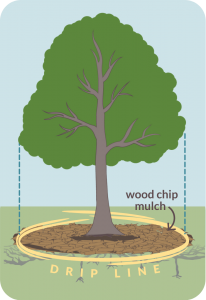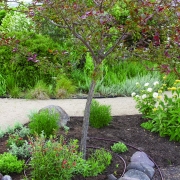Water Smart, Water Trees
As we enter our third consecutive dry summer and water storage levels are well below average it is important to use water wisely. You may want to consider prioritizing water use in your landscape by letting your lawn go dry and instead focus on deep and infrequent watering of your trees. Grasses and shrubs can grow back relatively quickly after periods of no rainfall. However, prolonged drought can cause severe stress to trees which can lead to disease and death.
Trees can take ten years or more to reach maturity and are a vital resource for our community. Trees store carbon dioxide, improve air and water quality, and provide much needed shade in our yards. Since trees are slow growing it is important to take care of them to ensure a healthy and resilient ecosystem.
Tips for maintaining healthy trees during a drought:

- Add mulch around the base of your trees. Mulch will help soil retain moisture and protect roots from extreme temperatures. Maintain a layer of 3-6 inches of mulch around the base of the tree but be sure to keep mulch away from the trunk of the tree. (Image courtesy of Sacramento Tree Foundation.)
- Check the soil moisture. Use a long screwdriver and push it into the soil around the roots below the canopy. If you can push the screwdriver in at least 6 inches and the soil is moist, then no need to water. If the soil is dry or it becomes difficult to probe before 6 inches, then it’s a good time to water.
- Water deeply but infrequently. Apply water through a drip irrigation system or a soaker hose. Apply water at the outer edge of the tree canopy. Be sure to follow your local jurisdiction’s watering restrictions. The best time to water is between 12am-6am to minimize water lost due to evaporation.
- Wait to water until the soil has completely dried out before applying more water. Newly planted tress (0-3 years old) will need more frequent irrigation than established trees.
To learn more about maintaining a low water use landscape, including irrigating trees, check out the Water Smart Gardens Maintenance Manual: https://www.savingwaterpartnership.org/programs_list/water-smart-gardens-maintenance-manual/
Developed by the Sonoma-Marin Saving Water Partnership and Ann Baker Landscape Architecture. The Water Smart Gardens Maintenance Manual provides a step-by-step guide to planting, watering and seasonal maintenance required for low water use landscapes.




